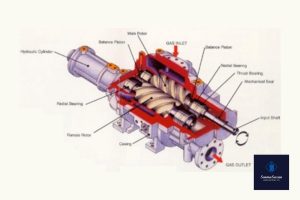Screw chillers are one of the main cooling devices known in the industry. These chillers use compressors called screw compressors, which are unique in their kind and even have other applications besides being used in screw chillers. The compressor has male and female rotors that can move each other or operate on timed gears.
Figure 1: Screw compressor in cross section

شماتیک کمپرسور چیلر اسکرو
Usually, the male rotor is connected to the motor and acts as the drive rotor, while the female rotor is driven. As the two rotors rotate, the volume of their grooves decreases, resulting in a reduction in refrigerant compression. We can see the operation steps in the following steps:
- Step 1: Take the refrigerant compressor inlet.
- Step 2: By moving the flood line in the direction of secretion, the tooth space is reduced. Compression takes place.
- Step 3: Compression continues until both rotors are in the discharge port. The pressure is high at this point.
- Step 4: With the seal line in the discharge, it empties the space of the refrigerant tooth
Types of screw compressors
Finding the right screw compressor can not differentiate the working principles of a screw compressor. In general, screw compressors are either single-screw or double-screw.
Single screw compressor
In fact, a single-screw compressor consists of a gate rotor as well as a main rotor. The main rotor, which is the drive rotor, is latticed with gate rotors to create the compression process.
Two screw compressor
Unlike single screw compressors, double screw compressors have two screw groove rotors. As two meshes, the fluid flows in the axial direction. This compressor is very common in commercial and industrial applications.
Screw compressor parts, components and duty cycle
Parts
The screw compressor is a positive displacement machine with two helical screw rotors that are latticed as shown in Figure 1. They create two rotors in one working chamber, which is the basis of the screw compressor. We can classify the parts as follows:
Rotor
There are two rotors, male and female. Typically, the female rotor is larger than the male rotor. It is also driven by the main drive and thus rotates the male rotor.
Suction valve
This is the part of the compressor where the gas is controlled, which is often controlled pneumatically or electrically.
Prime Mover (usually an electric motor)
Depending on the design, the compressor draws its power from the electric motor or any other main drive. You can also expect to find different powertrains with different manufacturers and models.
Oil sector
This includes the oil tank, oil filter and oil separator. Screw compressors are made of very precise parts. This includes couplings, gears, pistons, housing and belts. The screw compressor also has an air dryer whose job is to remove water vapor from the air. This prevents serious operational problems in the system, including process blockage and corrosion. Below are the other parts of the screw compressor, some of which can be seen in Figure 1.
- Screw (s)
- Rotors
- Input port
- Evacuation port
- Oil separator
- Sliding valves
Screw compressor applications
In the food processing industry, this product is important in food cooling, transport under pressure and stirring. This product is also featured in pharmaceutical facilities used in packaging, aeration and tablet production. In summary, the device is common in other industries:
- Civil and building engineering
- Device
- Dough and paper
- Electronic
- Cars
- Theme parks
Advantages of Screw Compressor
Many industries use screw compressors for ease of maintenance, overall savings and simplicity. The compressor has been praised for its high specific output, which crowns the usually small size of the devices. Due to the presence of several parts, the maintenance is flawless. With the new technology, you can expect the screw compressor to work efficiently as well. Fewer components means less vibration, another reason why area cooling facilities should install these compressors. Do not forget that there is almost no refrigerant loss for these products.
Screw compressor unit maintenance
When it comes to screw or screw compressor repair, the focus is obviously on the parts. How many parts should you consider? A screw compressor has a small number of main parts (only 4) oil parts, suction valve, aerator and electric motor. This is an advantage in terms of maintenance, because it is very little needed. This is a positive point in terms of maintenance, as it requires very little. Vibration can also be a problem in the area cooling plant and requires special equipment to control it. Fortunately, for screw compressors, vibration is minimal, so this cost is avoided. Even with these limited vibrations, it is still necessary to ensure that all connections are secure. Inspect screws, bolts and nuts regularly and tighten if loose. This equipment has internal moving parts that need attention. Remember that compressor oil has different functions – lubrication, cleaning and cooling. Planned oil change is very important because without it the equipment can be damaged. The compressor screw element is designed to work for about 40,000 hours. However, achieving this longevity is not guaranteed unless vibration, overheating, condensation and poor lubrication are used in the following cases. To prevent premature equipment failure, check bearing noise and oil leaks and contact a specialist in case of problems. In summary, here are some important equipment maintenance activities:
- Check for weather leaks
- Weekly oil status checks
- Weekly inspection and cleaning of filters
- Remove debris and dirt from the outside of the unit

 English
English  فارسی
فارسی 



